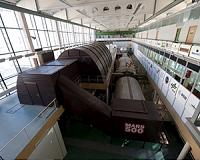 |
Bonn, Germany (SPX) May 14, 2010 Deposits of volcanic ash colour this view of the Meridiani Planum, captured by High-Resolution Stereo Camera on the Mars Express orbiter operated by the German Aerospace Center (Deutsches Zentrum fur Luft- und Raumfahrt; DLR). Meridiani Planum, a plain at the northern edge of the Southern Highlands of Mars, is located half-way between the volcanic Tharsis Region to the west and the low-lying Hellas Planitia impact basin to the southeast. Seen through a telescope, Meridiani Planum is a striking, dark feature, close to the martian equator. Meridiani Planum spans 127 x 63 kilometres, equivalent to an area of roughly 8000 square kilometres, about the size of Cyprus. It was chosen as a central reference point for Mars' geographical coordinate system. The martian Prime Meridian, the equivalent of the Prime Meridian on Earth (Greenwich, UK), has been set to run through this region. The High-Resolution Stereo Camera (HRSC) on the European Space Agency's Mars Express orbiter acquired this image on 1 September 2005 during orbit 2097, at a resolution of about 13 metres per pixel. In the centre of the image, the floor of an impact crater almost 50 kilometres wide is covered in dark material. It resembles volcanic ash, which is predominantly composed of minerals such as pyroxene and olivine. Small mounds, probably composed of more resistant material, are visible protruding through the dark material. The softer material around them has been eroded and blown out of the crater by northeasterly winds and now forms dark streaks on the surroundings. An impact crater to the upper left, just 15 kilometres wide, exhibits the same dark material on its southwestern edge. It is likely that this material was blown in to the smaller crater from the larger one. The nearly black structures are almost certainly dunes, composed of volcanic-ash rich sediments. In contrast, the 34-kilometre-wide impact crater to the lower right of the image is filled largely with light material. The southern area, to the left of the image below the smaller crater, exhibits dark features. Located on the lee side of ridges, these are probably similar deposits of ash-rich material, again blown out of the crater. The High Resolution Stereo Camera (HRSC) experiment on the European Space Agency's Mars Express mission is led by the Principal Investigator (PI) Prof. Dr Gerhard Neukum, who was also responsible for the technical design of the camera. The science team of the experiment consists of 45 Co-Investigators from 32 institutions and 10 nations. The camera was developed at the German Aerospace Center (DLR) under the leadership of the PI, G. Neukum, and built in cooperation with industrial partners (EADS Astrium, Lewicki Microelectronic GmbH and Jena-Optronik GmbH). The experiment on Mars Express is operated by the DLR Institute of Planetary Research, through ESA/ESOC. The systematic processing of the HRSC image data is carried out at DLR. The scenes shown here were processed by the PI-group at the Institute for Geosciences of the Freie Universit�t Berlin in cooperation with the DLR Institute of Planetary Research, Berlin.
Share This Article With Planet Earth
Related Links High-Resolution Stereo Camera Mars News and Information at MarsDaily.com Lunar Dreams and more
 Mars500 European Crew Selected And Ready To Go
Mars500 European Crew Selected And Ready To GoParis, France (ESA) May 11, 2010 The simulated flight to Mars is almost ready to depart! Selection of the full crew is still under way, but the Europeans have now been chosen: Romain Charles and Diego Urbina. Two Europeans, three Russians and one Chinese will close the hatch of the Mars500 isolation modules in early June and start their record-breaking mission. The full crew will be announced later in May, but the E ... read more |
|
| The content herein, unless otherwise known to be public domain, are Copyright 1995-2010 - SpaceDaily. AFP and UPI Wire Stories are copyright Agence France-Presse and United Press International. ESA Portal Reports are copyright European Space Agency. All NASA sourced material is public domain. Additional copyrights may apply in whole or part to other bona fide parties. Advertising does not imply endorsement,agreement or approval of any opinions, statements or information provided by SpaceDaily on any Web page published or hosted by SpaceDaily. Privacy Statement |